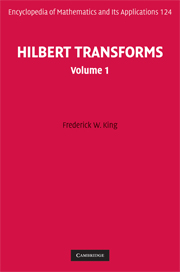Book contents
- Frontmatter
- Contents
- Preface
- List of symbols
- List of abbreviations
- 1 Introduction
- 2 Review of some background mathematics
- 3 Derivation of the Hilbert transform relations
- 4 Some basic properties of the Hilbert transform
- 5 Relationship between the Hilbert transform and some common transforms
- 6 The Hilbert transform of periodic functions
- 7 Inequalities for the Hilbert transform
- 8 Asymptotic behavior of the Hilbert transform
- 9 Hilbert transforms of some special functions
- 10 Hilbert transforms involving distributions
- 11 The finite Hilbert transform
- 12 Some singular integral equations
- 13 Discrete Hilbert transforms
- 14 Numerical evaluation of Hilbert transforms
- References
- Author index
- Subject index
1 - Introduction
Published online by Cambridge University Press: 04 May 2010
- Frontmatter
- Contents
- Preface
- List of symbols
- List of abbreviations
- 1 Introduction
- 2 Review of some background mathematics
- 3 Derivation of the Hilbert transform relations
- 4 Some basic properties of the Hilbert transform
- 5 Relationship between the Hilbert transform and some common transforms
- 6 The Hilbert transform of periodic functions
- 7 Inequalities for the Hilbert transform
- 8 Asymptotic behavior of the Hilbert transform
- 9 Hilbert transforms of some special functions
- 10 Hilbert transforms involving distributions
- 11 The finite Hilbert transform
- 12 Some singular integral equations
- 13 Discrete Hilbert transforms
- 14 Numerical evaluation of Hilbert transforms
- References
- Author index
- Subject index
Summary
Some common integral transforms
Transform techniques have become familiar to recent generations of undergraduates in various areas of mathematics, science, and engineering. The principal integral transform that is perhaps best known is the Fourier transform. The jump from the time domain to the frequency domain is a characteristic feature of a number of important instrumental methods that are routinely employed in many university science departments and industrial laboratories. Fourier transform nuclear magnetic resonance spectroscopy (acronym FTNMR) and Fourier transform infrared spectroscopy (FTIR) are two extremely significant techniques where the Fourier transform methodology finds important application. Two transforms derived from the Fourier transform, the Fourier sine and Fourier cosine transforms, also find wide application. The Laplace transform is often encountered fairly early in the undergraduate mathematics curriculum, because of its utility in aiding the solution of certain types of elementary differential equations. The transforms that bear the names of Abel, Cauchy, Mellin, Hankel, Hartley, Hilbert, Radon, Stieltjes, and some more modern inventions, such as the wavelet transform, are much less well known, tending to be the working tools of specialists in various areas. The focus of this work is about the Hilbert transform. In the course of discussing the Hilbert transform, connections with some of the other transforms will be encountered, including the Fourier transform, the Fourier sine and Fourier cosine offspring, and the Hartley, Laplace, Stieltjes, Mellin, and Cauchy transforms. The Z–transform is studied as a prelude to a discussion of the discrete Hilbert transform.
- Type
- Chapter
- Information
- Hilbert Transforms , pp. 1 - 10Publisher: Cambridge University PressPrint publication year: 2009

